Modular LPDDR Memory Becomes A Reality: Samsung Introduces LPCAMM Memory Modules
by Ryan Smith on September 25, 2023 10:00 PM EST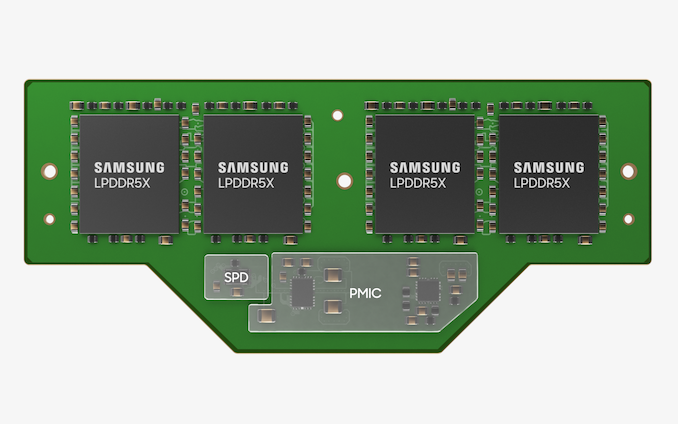
Although Low Power DDR(LPDDR) memory has played a pivotal role in reducing PC laptop power usage, the drawback to the mobile-focused memory has always been its tight signaling and power delivery requirements. Designed to be placed close to its host CPU in order to minimize power expenditures and maximize clockspeeds, LPDDR memory is unsuitable for use in traditional DIMMs and SO-DIMMs – instead requiring that it be soldered down on a device in advance. But it looks like the days of soldered-down LPDDR memory are soon at an end, as this evening Samsung is announcing a new standard for removable and modular LPDDR memory: LPCAMM.
Pitched as an LPDDR-centric version of the upcoming Compression Attached Memory Module (CAMM) standard for removable mobile memory, Low Power Compression Attached Memory Module (LPCAMM) is Samsung’s take on using the same style of compression connector interface for LPDDR memory. The net result is that, thanks to the more exacting specifications and shorter trace lengths used by a CAMM-style connector, Samsung says it’s possible to have modular and swappable LPDDR5 memory at last. And all in a fraction of the space a traditional SO-DIMM setup would occupy.
While the CAMM format has barely gotten off of the ground itself – JEDEC has yet to even approve the standard – Samsung is essentially opting to run with the idea to do something different with it by focusing on LPDDR memory. Notably, however, the resulting LPCAMM form factor is incompatible with CAMMs – both physically and electrically – so despite the similar names and use of compression connectors, the two are not interchangeable. But both pursue the same ideas for their respective memory types.
| Laptop Memory Module Standards | ||||
| AnandTech | LPCAMM | CAMM | SO-DIMM | Soldered |
| Memory Type | LPDDR5X | DDR5 | DDR5 | LPDDR5X |
| Max Official Data Rate | 7500 MT/s | 6400 MT/s? | 6400 MT/s | 8533 MT/s |
| Current Max Capacity | 128GB (Planned) | 128GB | 192GB (48GB x 4) |
32GB (per 64-bit bus) |
| Bus Width | 128-bit | 128-bit | 64-bit | Variable |
| Dimensions | 78mm x 23mm | ? | 67.6mm x 30mm | Variable |
LPCAMM is already in development at Samsung for a 2024 commercial release, and for this evening’s announcement Samsung sent over a render of an LPCAMM module. Which, combined with the company’s press release, provides a wealth of technical details on the new memory form factor.
The immediate takeaway is that with LPCAMM, Samsung is placing 4 x32 LPDDR5X memory packages directly over the compression connector, allowing for a 128-bit memory bus on a single memory module. While Samsung didn’t provide us with a picture/render of the opposite side, we’re told it’s basically all signal pads on the opposite side, similar to the connector portion of a full-size CAMM module.
Update 09/26: Samsung has since sent us over an additional set of diagrams of the pads, including the reverse side of the LPCAMM module. This illustrates very well the relationship between the positioning of the LPDDR5X memory modules and the signal pads below them.
Critically, because the LPDDR5X chips are directly over the connector, this minimizes the distance a signal travels between the host memory controller and memory chips. Even CAMMs, which reduced this distance, still required some distance for the signal to travel along the module from the connector to the memory chips farther away. In other words, Samsung has essentially created a socket form factor for LPDDR memory, with only the bare-minimum trance length and PCB between the chips and the motherboard.
The module itself measures 78mm x 23mm. Besides the DRAM packages themselves, the only other electronics on an LPCAMM module are the SPD, and the power management IC(PMIC). Which, like the CAMM standard, allows a module to provide for its own voltage regulation and identification. Since these components aren’t as sensitive to signal integrity and take up a decent bit of space themselves, they’re offset from the connector portion of the LPCAMM.
For their first generation of LPCAMM modules, Samsung is looking as capacities of 32GB, 64GB, and 128GB, with data rates up to LPDDR5X-7500. Samsung doesn’t currently have any 256Gbit LPDDR5X memory modules in their catalog, so either the company has a way to fit 8 modules on to an LPCAMM, or more likely they intend to introduce larger memory modules by the time LPCAMMs ship next year. Otherwise the data rate is a tier below Samsung’s best memory modules (8533 MT/sec), but I wouldn’t be surprised to eventually find out that it’s the trade-off for having modular LPDDR memory.
According to Samsung, they’ve already verified their LPCAMMs with an unnamed Intel platform – almost certainly Raptor Lake mobile, given the timing of the announcement. Though nothing about LPCAMMs is vendor-specific, and if the form factor is successful, I wouldn’t be surprised to see laptop manufacturers also pick it up for AMD designs.
Looking at the bigger (smaller?) picture, Samsung is pitching LPCAMMs as a crossover solution for offering a flexible amount of low-power memory in laptops, and perhaps more interestingly, servers. Currently system vendors wanting to install LPDDR have to solder the memory down at the time of manufacture, which means that there’s no further opportunity to adjust the amount of memory after the fact. So for modular memory, vendors (and customers) are stuck choosing between a fixed amount of LPDDR or a flexible amount of DDR on SO-DIMMs. LPCAMMs would be a middle-ground solution, allowing a flexible amount of faster LPDDR memory on a package smaller than SO-DIMMs (and with a lower total capacity), but still a bit larger than a compact and optimized soldered-down solution. The net result would be that system vendors could customize systems and install the appropriate amount of memory when the system is ordered, and laptop owners could swap in a larger LPCAMM farther down the line as a system upgrade.
The proposed use case for servers is quite similar as well. Servers are increasingly using LPDDR memory for improved performance and lower memory power requirements, such as with NVIDIA’s Grace platform. So a modular solution would allow server vendors to similarly configure systems at build time, and to do memory upgrades down the line without having to swap out the entire motherboard/system.
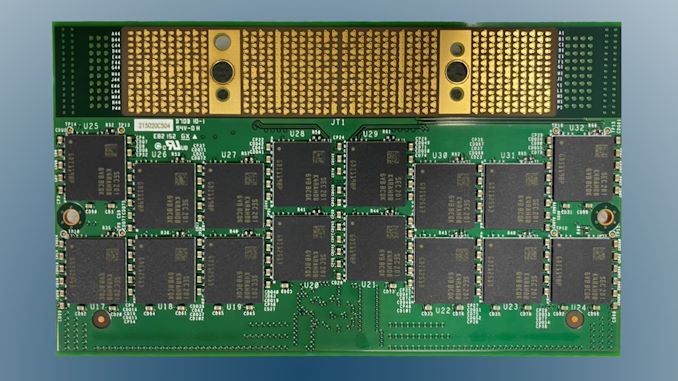
For comparison: the connector side of a pre-standardization Dell DDR5 CAMM module
For the moment, Samsung isn’t saying how LPCAMM compares to soldered LPDDR5X memory with regards to size or performance – it's bigger and likely a bit more power hungry due to trace lengths. Otherwise, as a replacement for SO-DIMMs, Samsung says that LPDDR5X LPCAMMs only occupy 40% of the space of a DDR5 SO-DIMM, and improve power efficiency by up to 70%, roughly in line with the general benefit of LPDDR5X over DDR5.
But even with this newfound flexibility, don’t expect to see LPCAMMs replace soldered LPDDR memory – at least not wholesale. Besides the higher qualified speeds for a soldered solution, LPCAMMs can’t match the smaller footprint of a soldered solution, especially as vendors are starting to put LPDDR memory directly on chip packages (i.e. Apple). Depending on the cost of implementation, LPCAMMs may displace soldered-on-motherboard memory, while ultraportable devices will increasingly embrace soldered-on-package memory to maximize space and efficiency.
As for standardization, according to Samsung they are working with partners to get a JEDEC standard for LPCAMMs. All the while, the JEDEC announced back in March that they were also working on extending the CAMM standard to cover LPDDR memory, using the same connector for both DDR5 and LPDDR5. At this time we’ve heard no further information from the group, and absent a ratified CAMM standard, it’s unclear if JEDEC is still moving forward with their LPDDR proposal. Ultimately, we may yet see rival CAMM-style standards for LPDDR memory, depending on how standardization shakes out.
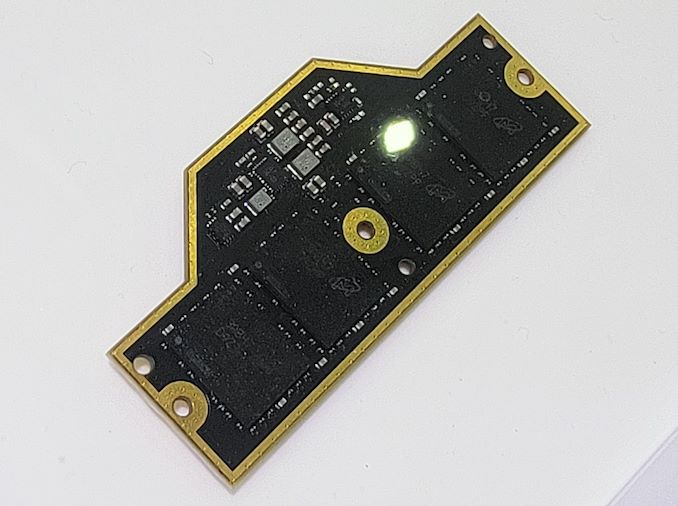
A suspicious compression attached memory module spotted at ADATA's Computex 2023 both in June
In any case, it looks like Samsung has already been working with at least one partner for several months. When scrolling through our archives, we spotted a picture of an LPCAMM module on the show floor of Computex 2023. Taken at ADATA’s booth, the module was labeled a CAMM, but is clearly in the LPCAMM form factor, giving us an idea of what a physical LPCAMM module looks like.
Wrapping things up, we expect to hear more about LPCAMM (and CAMM) in the coming months, especially as the later is finally standardized. If all goes according to plan, Samsung expects to be commercializing LPCAMMs in 2024, which should line it up to ship in systems based on Intel’s next-generation Meteor Lake platform.


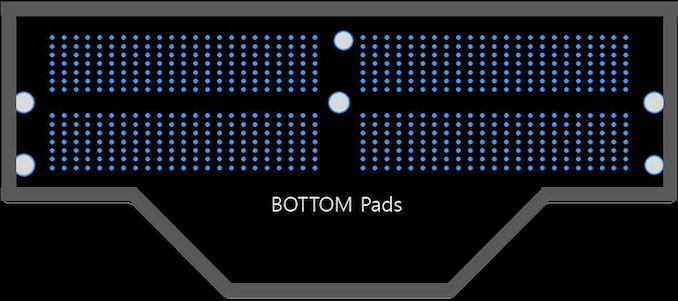
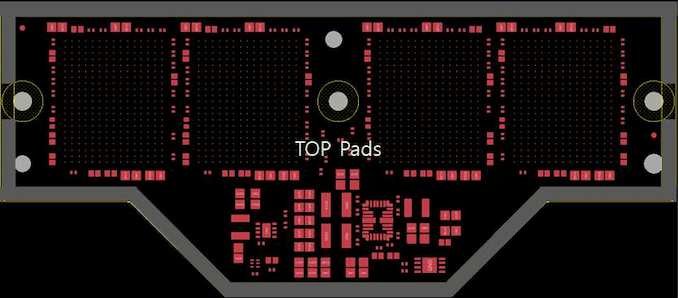








29 Comments
View All Comments
ballsystemlord - Tuesday, September 26, 2023 - link
Awesome news! Now we can finally buy memory modules for laptops again.FWhitTrampoline - Thursday, September 28, 2023 - link
There was a time where some Laptops offed Socket Based Motherboards and the processors there could be replaced or upgraded but that's not the case currently! And so eWaste is an issue there just as it is for Laptops that come of soldered down memory modules, And those mini desktop PCs and AIOs should come with LGA based MBs where processors can be replaced and eWaste reduced.Brane2 - Thursday, October 5, 2023 - link
Time has passed since then, but speed of light stayerd the same. Meanwhile the transfer speeds ahve shot up insanely and took impedance and signal noise requirements with them.But if you want old machines, you can still have them. Ebay is full of old clunkers.
Equations are simple: electricity isn't a simple water and singal traces aint your garden hose.
High speed needs short traces of great quality.
If you need high speed, there is no way around direct connect to the DRAM chips.
If you need more than what is on the board, resolder damn chips.
Violet Giraffe - Sunday, October 1, 2023 - link
What are you on about? Simply don't buy the bullshit toy "laptops" without a memory socket.Samus - Monday, October 2, 2023 - link
Fact is, other than some Dell portable workstations with CAMM, laptops with soldered memory are higher performance and quite the opposite of toys.dontlistentome - Wednesday, October 4, 2023 - link
Plenty of laptops have socketed RAM (i've just upgraded a bunch of Dell Precision XPS 15s to 64GB).There's a reason manufacturers don't like socked RAM - few people ever touched it and it makes the laptop thicker.
The other thing supporting laptops - many of the errors I dealt with were memory related - as the machines got bashed around or got hot there were issues with the seating.
sjkpublic@gmail.com - Tuesday, September 26, 2023 - link
guessing this is not 'fixed' memory. really want HBM memory.ballsystemlord - Tuesday, September 26, 2023 - link
But do you really want HBM pricing? Recall that Vega was sold at a loss according to some people because of the HBM memory.ballsystemlord - Tuesday, September 26, 2023 - link
And that was HBM gen 1. The newer gens cost even more.skinnyelephant - Saturday, September 30, 2023 - link
I assume it got cheaper by now due to larger production and technology maturing.